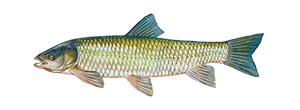Grass Carp

Species Details
Ctenopharyngodon Idella
Cyprinidae
Cypriniformes
Lake, River, Backcountry
40 - 97 lbs.
16" - 59"
Grass Carp (Ctenopharyngodon idella) Fish Description
The Grass Carp (Ctenopharyngodon idella), also known as white amur or silver orf, is a medium to large freshwater fish related to minnows. It can easily be identified with its large, often silvery overlapping scales, made more prominent by each scale’s dark edges. Its plump, elongated body and its big head make its eyes look quite small. And from its white bellies, its color gradually darkens upwards until it becomes olive-green to grey at the top part of the fish.
The species is an herbivore or a plant-eater and originally comes from Asia, specifically from northern Vietnam to the Amur River on the Siberia-China border. It was first introduced into the US waters in the early 1960s for controlling invasive aquatic plants in reservoirs and fish farms. It has since then spread throughout the country and became a favorite target by both experienced anglers and hopeful beginners—not just because of its impressive size, but also because catching it is quite challenging.
Interesting Facts About Grass Carps
- The world record for biggest Grass Carp caught was an 89 pounder that measures almost 5 feet long at Hungary's Danube in 1993 by angler Sandor Szeles.
- While adults are herbivores, babies tend to be omnivorous.
- They’re picky eaters and mostly prefer American waterweed and thin-leaved pondweeds over any other aquatic plants.
- They can live for at least ten years in the wild or in captivity.
- Even if they mostly live in freshwater, they can actually adapt to brackish waters.
- They were introduced in the US for weed control.
- They prefer large, slow-flowing or standing water bodies with vegetation.
- They can live in freezing water temperatures; although they’re mostly dormant during winter.
- They are favorite fishing targets for both sports and consumption.
- They can be fierce fighters when hooked as they’re known to go airborne—even when caught with a net.
- Experienced Grass Carp fishers and farmers often wear masks and pads for protection.
- They’re cultivated in China for food.
- Serving a Grass Carp whole in China is a symbol of prosperity.
Grass Carp Average Speed and Size
Although they are not known to be fast swimmers, Grass Carps actually has the ability to dart away quickly when spooked. They typically reach sizes of 65 to 80 pounds in their natural habitat, but, a few 400-pounder sightings have been reported—that is, if these reports are to be believed, of course.
Where to Find Them
Grass Carps can typically be found in lakes, ponds, pools, and backwaters of large rivers. They often prefer large, slow-flowing or standing waters with an abundant supply of aquatic plants in which they forage for food. And because they are able to adapt well in our waters, they’ve spread widely across the country since their introduction in the ’60s. You can practically find them in every state except Alaska, Maine, Montana, Rhode Island, and Vermont.
Grass Carp Fishing Tips
Catching a Grass Carp is definitely not going to be that easy. Aside from it being known as a tough fighter when hooked, this fish species can really be hard to lure into your trap as it’s known to be a picky eater and incredibly fidgety. If you’re thinking of catching one, you might want to check out these tips that can help you land this prize fish:
Equipment – a medium-sized 7-foot rod and 200-yard line combo is highly recommended for Grass Carp fishing as it provides enough sensitivity to feel the bite and at the same time, strong enough to handle what’s going to be a long hard battle of reeling in the fish. You will also need to use a small circle hook as will let go of your bait if they feel the hook. And because they’re known to fight to the last breath, you will definitely need a landing net to help you bring in this beast of a fish.
Chumming – to help in attracting this particularly hard to catch fish, you’re going to need all the help you can get. Increase your chances of catching one by chumming the area you think these fish are in abundance. Sweet corn is probably the best choice for chumming as it’s been observed that it’s one of the carp’s favorites.
Bait – as mentioned, they are picky herbivores; but they seem to find cherry tomatoes, watermelon, and even fresh-cut grass irresistible.
Patience – yes, you should always be calm, patient, and be very still while waiting for a bite as Grass Carps can easily be spooked with sudden movements and sounds.







